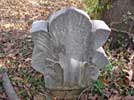Minutes of the Friends of the Geer Cemetery 07/07/2008 4:00 PM
At the Home of Jessica and David Eustice
809 Colonial Street, Durham
Call Meeting to Order
Greetings and Introductions
John Clauser’s rough estimate for Archeological work:
Fieldwork…………………………………………………$3000.00
Scaled Map with graves ………………………………….$2000.00
Complete indexing of headstones with photographs ……..$1000.00
Suggests FOGC does the indexing work
Preservation Plan and timing of FOGC work – what to do when
Stakes to mark out grid for mapping – the stakes will have to be brightly colored so they can be seen, and low enough to the ground not to interfere with potential mowing. Maybe a lumber company could donate these stakes. We can mark off sections of 50 sq. ft. so that we will not need as many stakes.
Ron Barholomew’s drawing and Sign Proposal. His crew will do the work.
Revision of the wording for the back of the sign:
In 1876, an 11 year old African American farmhand was buried here, on what was Jesse Geer’s farm. This area became a cemetery for African Americans in a time of segregation. In 1877, two acres were sold to a burial society for African Americans. The Cemetery was closed by the Durham City Health Department in 1944. Well over 1500 people were buried here; among them, Dr. Augustus Shepard, Edian Markham, and Margaret Ruffin Faucette.
Notes from research:
A Cemetery preservation Primer
People who died between 1901-1916
Dr. Moore from Durham’s Hayti married to Sarah Cottie Dancy Moore and was the father of Mattie L. McDougald and Lydia V. Merrick
Call to the State Property Tax Office about repossessing abandoned Cemeteries – referred me to Shea Denning w/ the School of Government 843-5120.
Some email addresses have changed:
chantaebohannon@yahoo.com
Very Important Info from:
Lynette Strangstad, A Graveyard Preservation Primer, 1995, AltaMira Press, Walnut Creek, CA (www.altamirapress.com)
The Association of Gravestone Studies, 30 Elm St., Worcester, MA 01609
Good Signs:
Opening and closing hours
Gravestone rubbing regulations
Warnings of potential danger
Appropriate educational and interpretive information
Information about an ongoing preservation project
The number to call to make inquiries and report problems
Collecting Data:
Existing Documents
Church records
City records
Local history societies
Local libraries
Transcribing inscriptions on stones
Using Mirrors to reflect sunlight aiding the transcription process
Collecting Data on form (sample appendix B A Graveyard Preservation Primer by Lynnette Strangstad pp.97-98)
Recording Detailed information about each Grave marker
Documentation of Repairs and Condition of Stone
Carver’s Attributions
Photographs
Mapping the Cemetery
Archeological Survey
Cleaning and maintaining the Site:
Ideally documentation of the entire cemetery should take place before clean up. If this is not possible, be sure no fragment is moved prior to documentation.
Good maintenance does not necessarily imply a manicured appearance; indeed an old cemetery’s atmosphere may be enhanced by a relaxed but controlled growth of wildflowers and grasses.
Do not use commercial herbicides or fertilizers near gravestones. They often contain salts and acids damaging to most stones.
Benches and trash receptacles should be provided to reduce littering and leaning on stones.
Caring or stone fragments … (p. 51)
Landscaping (p.53)
Finding a gravestone conservation professional (p.56)
Cleaning old Gravestones (p.60)
Resetting Old Gravestones (p. 63)
Probing (p.73)
Removal of Stones: A Question of Ethics (p. 86)
Public Awareness:
Slide lectures given to schools and civic groups can stimulate students, teachers, and parents and can lead to a variety of projects.
Tours guided by knowledgeable members of the community can generate excellent publicity.
A printed guide or brochure featuring stones chosen for their artistic, historical, architectural, humorous, or other features can serve as an educational tool and a fundraiser as well.
Working With Volunteers:
The involvement of a large number of volunteers in a complex project requires not only careful planning but also a volunteer coordinator.
Training workshops:
Are essential for volunteers who are to become involved with actual hands-on preservation work.
Suggested Regulations for Visitors making Grave Stone Rubbings:
- The Cemetery is open from ___ to ___.
- The Cemetery management is not responsible for injury to visitors.
- No running or jumping on stones or swinging or leaping from stone to stone is permitted. Failure to comply could result in serious damage to both visitors, and stones.
- Children in the cemetery are to be supervised at all times. Children under ten years of age shall not rub stones even with supervision.
- Limit gravestone rubbing to sound stones only. Before proceeding, check each stone for stability. If a given stone appears fragile or unsound in any way, choose another stone.
- Limit the cleaning of a stone to dusting with a soft bristled-brush. Do not attempt to remove lichens or moss that may be growing on stones. Never use a wire brush on gravestones.
- Use a heavy grade paper so charcoal, wax or ink does not bleed through onto the stone.
- Cover the image amply with paper to avoid over-rubbing onto the stone. Do not make marks on the stone.
- Attach paper with masking tape to the back of the stone. Be sure to remove all bits of tape from the stone and the nearby ground before leaving.
- Avoid rubbing deeply carved stones. Such stones can easily be damaged and generally do not make good rubbings anyway.
- Avoid rubbing marble or other stones with coarse-grained textures, as coloring agents may bleed through the paper onto the stones.
- The best choices of stones for rubbing are slate stones in good condition with low relief or incised carvings. These produce the best images on paper and are less easily damaged inadvertently.
Check the work site before leaving to be sure no tape, paper, or trash has been left behind.
Minutes submitted by Jessica Eustice, 7/14/08 |



